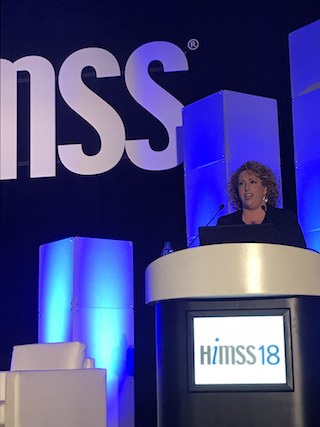 There’s no doctor onboard the International Space Station. Because of the costs associated with shipping anything up to space, there’s a carefully chosen selection of medical supplies and devices. For everything else, the six international astronauts that live and work on the station rely on NASA’s own brand of telemedicine.
There’s no doctor onboard the International Space Station. Because of the costs associated with shipping anything up to space, there’s a carefully chosen selection of medical supplies and devices. For everything else, the six international astronauts that live and work on the station rely on NASA’s own brand of telemedicine.
“Telemedicine really is our only resource,” Dr. Shannan Moynihan, deputy chief of space and occupational medicine at the NASA Johnson Space Center, said in a presentation at HIMSS18. “Unfortunately we don’t get to make house calls. I’ve tried that, it didn’t fly.”
Crew members get a small amount of emergency medical training and some instruction on medical hardware while they’re still on earth, but it has to fit in among a very packed and rigorous training schedule. When a crewmember has a medical issue, the first stop is usually a live video link with an on-call flight surgeon back on Earth.
Moynihan said many of the injuries they deal with are complaints that could occur here on terra firma.
“We get calls for bumps, and bruises, and little lacerations or cuts,” she said. “A typical scenario might be a newbie, somebody who just got up there, trying to superman through a hatch and not quite making it. So we get a call for a little bump on the forehead and we help them figure out how to take care of that.”
But many other conditions are unique to life at 250 miles up. Microgravity can wreak havoc on astronauts’ vestibular systems and fluid balances, and the recycled air system makes CO2 poisoning a larger risk.
And because humans living in space for six months to a year is still a fairly new scenario, sometimes they’re dealing with medical mysteries.
“Basically about eight to 10 years ago we noticed our long duration crewmembers were coming back with more pronounced visual changes and actually some structural changes in their eyes,” Moynihan said. “We started a program to find out more about what we were dealing with and very quickly realized we needed to expand our telemedicine capability as a result.”
The condition has been termed Spaceflight-Associated Neuro-Ocular Syndrome, or SANS, and learning more about it is a top priority of Moynihan’s team. To do that, they’ve had to figure out how to get astronauts without medical training to do a battery of optical tests on themselves. NASA was concerned enough about SANS to ship a special scanner, an optical coherence tomography unit, up to the station.
But most medical exams and research readings — including ongoing research into SANS — are taken on a modified Vivid q ultrasound machine from GE Healthcare that’s been on the station since 2002.
“We have no X-ray and no MRI machine,” Michelle Frieling, department manager for flight and medical operations at KBRwyle, which works with NASA, said. “So the ultrasound is our medical imaging device that we have to use. This has allowed us — and forced us — to be more creative with our use of ultrasound and use it in novel ways that it’s not usually used here on earth.”
Some of those new telemedicine ultrasound techniques were so useful they’re now being used in extreme environments here on earth.
 The ultrasound has been rigged to be able to send data efficiently using ground control’s limited and densely scheduled uplink, and to use water instead of ultrasound gel, which would be one more thing to fly up to the station regularly. But it’s also been modified to be as usable as possible by non-medical professionals being walked through the process by a remote guidance team.
The ultrasound has been rigged to be able to send data efficiently using ground control’s limited and densely scheduled uplink, and to use water instead of ultrasound gel, which would be one more thing to fly up to the station regularly. But it’s also been modified to be as usable as possible by non-medical professionals being walked through the process by a remote guidance team.
“Our ultrasound is going to be used by minimally trained individuals,” Frieling said. “So the color coding really helps them orient themselves and find the buttons faster. It might be a fighter pilot or an engineer, and they might be American, Japanese, or Russian. So being able to tell someone ‘I need a purple up arrow’ or ‘I need you to push the green three button’ is much faster than expecting them to fully understand the tech keyboard. That’s been a great time saver for us.”
NASA may have perfected telemedicine for the astronauts on the ISS, but those techniques aren’t going to work for everything the agency has planned.
“As we get further away from our home here on earth, we’re talking about an increased delay in the communications we already have,” Moynihan said. “And of course that’s going to have a big impact on how we do all of our operations, not just our medical operations in telemedicine.”
As NASA thinks about going back to the moon and even heading further out into the solar system, their approach to medical care will need to change.
“For example, if we’re talking about Mars it’s 18 to 20 minutes one way for an audio signal to get there,” Moynihan said. “That really takes telemedicine for an acute issue out of commission. We need to start thinking outside the box and thinking differently. We need our crews to be more autonomous. There needs to be more capability onboard, both technology and training. Will there be a physician onboard? Hopefully.”



















